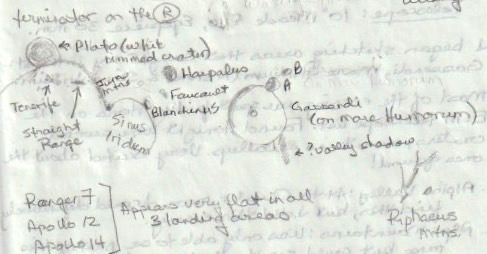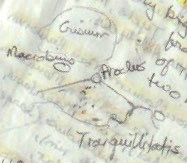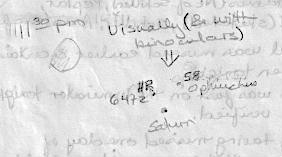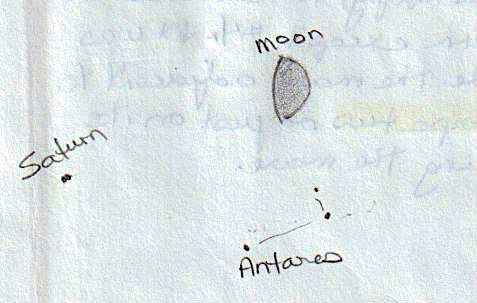Lunar Phase: Waxing Gibbous (87.7%)
Q-Day: +3
Moonset: 2:29 AM Moonrise: 5:37 PM
Sunrise: 6:03 AM Sunset: 8:38 PM
Location: Home
Date: 2017-08-03
Time: 8:15 PM – 11:40 PM
Temperature: 20° C - 17° C
Equipment: 10” Meade SCT, 10 mm + 30 mm eyepiece; Binoculars 10x30 IS
Magnification: x250 + x83; x10
Transparency: not recorded
Seeing: not recorded
 |
Mostly clear skies that clouded over much of the sky as the night went on until ~ 11:15 PM when there was just a clear patch around the Moon. Most of the evening was spent on the ETM (telescope version) list. Found tonight were several craters, mountains, and valleys. Very excited about the ones found!
|
I was surprised that having missed one night of observing due to cloud cover that so many items could be seen tonight. I started with 30 mm eyepiece to sketch areas that caught my interest: Gassendi, Mare Iridium (north shore) and Sinus Iridum.
- Vallis Apennine: Found this tonight and at the Quarter Moon.
- Montes Alpes: Was only able to see part of this range previously but can see it all this evening.
- Confirmed I could re-find the following:
-
- Mountains: Apennine, Spitzbergen, Tenerife
- Craters: Archimedes, Aristillus, Autolychus, Clavius, Copernicus, Maginus, Plato, Timocharis, Tycho
- NEW tonight:
-
- Maria: Humorum, Imbrium, Iridum, Oceanus Procellarum
- Mountains: Carpatus, Jura, Montes Recti (Straight Range), Riphaeus (sketched)
- Craters: Aristarchus, Bullialdus (large, raised centre), Gassendi (sketched), Kepler, Lansberg, Longomontanus (NE of Schiller), Reinhold, Schiller, Wilhelm (very little rim)
- The Straight Wall (Rupes Recta) was missed before and certainly couldn’t be seen this evening either.
- Crater Mersenius was just on the terminator tonight and couldn’t be verified.
10:44 PM
I switched to the 10 mm eyepiece. Between Maria Crisium and Tranquilitatis was a very brightly lit circular crater rim with 2 rays emanating from it. I asked Dave Chapman about this and he explained they were called “rays” (deposits of light-coloured material from impacts). One ray touched the mountain/mare edge of Tranquilitatis whereas the other went between the two maria and faded into the landscape. The field between this crater and Tranquilitatis is darker than the field between it and Crisium. It had many white-rimmed very small craters or raised cones.
| NOTE: On March 21, 2021, I learned this fan-shaped area was Palus Somni with Proclus as the bright crater on its rim. The bright areas within were minor craters. |  |
There were some areas seen that weren’t labelled on the RASC map provided:
- Palus Putredinus (Marsh of Decay): Looked this up. Area that stretched from the centre of Archimedes southeast to the edge of Mare Imbrium and the Apennines. Autolychus in the north. Apollo 15 landing site!
- Mare Insularum (Sea of Islands): Located in the Insularum basin south of Mare Imbrium. Bordered by the craters Copernicus on the east, Kepler in the west. Oceanus Procellarum joins the mare in the SW.
- Mare Cognitum (the Sea that has become known): Located in a basin that sits in the second ring of Oceanus Procellarum. The Montes Riphaeus are to the NW. Ranger 7 landed here.
 |
Feeling better and more comfortable with identifying reverse images of the Moon. Almost makes sense now. 11:30 PM |
